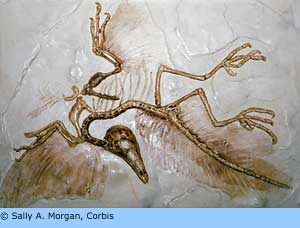A origem das aves
Most scientists believe that birds and mammals both evolved (developed gradually) from reptiles. However, scientists know far more about the evolution of mammals. Scientists learn about the development of animals by studying fossils, especially the remains of bones. Mammals have teeth and relatively hard bones and so have left behind many well-preserved fossils. The bones of birds, however, are extremely fragile. As a result, fewer bird fossils have been preserved, and most of these are of large birds. The first known birds
A fossil of an archaeopteryx shows its reptilian-like features.
At some point in the evolution of birds from reptiles, there must have been various kinds of birdlike reptiles. Such creatures would have structures intermediate between reptile scales and bird feathers. However, no fossil of any such birdlike reptile has yet been found.
The earliest bird fossils belong to a genus (group) called Archaeopteryx. Archaeopteryx lived about 140 million years ago. It resembled a reptile in many respects. However, it had feathers like those of modern birds. The first Archaeopteryx fossils were found during the mid-1800's. Altogether, seven fossils-six partial skeletons and a single feather-have been found. Six of the fossils were found in limestone beds in southern Germany. The best-preserved of these specimens shows the imprint of almost all the skeleton plus the flight feathers.
In 1988, scientists found a large Archaeopteryx fossil in a private collection in Bavaria. The specimen, which is about the size of a raven, had been misidentified as the skeleton of a small dinosaur. Unlike modern birds, Archaeopteryx had teeth, a reptilelike tail, and three claws on each wing. It may have used these claws to climb trees. Scientists believe Archaeopteryx could fly, but probably only weakly.
The next well-preserved bird fossils date from about 90 million years ago. The best-known birds of that time are Hesperornis and Ichthyornis. Both were water birds that lived in what is now the Midwestern United States. At that time, a large inland sea covered most of the region. Hesperornis and Ichthyornis almost certainly ate fish. Like Archaeopteryx, both had teeth. But in other ways, they looked more like modern birds than did Archaeopteryx. Hesperornis somewhat resembled a modern grebe or loon. It could not fly but was a strong underwater swimmer. Ichthyornis could fly and looked somewhat like a small gull.
Development of modern birds
The first modern birds appeared by about 65 million years ago. Unlike earlier birds, they resemble species that still exist. Most of them were toothless water birds. They included the ancestors of today's ducks, flamingos, and pelicans. The ancestors of most other modern birds evolved between about 65 million and 13/4 million years ago. They included the first falcons, ostriches, owls, penguins, and wild fowl. About 2 million years ago, the Pleistocene Epoch began. During this epoch, there were several periods when great glaciers covered much of Europe and North America. By the time the last glacier retreated--about 11,500 years ago--almost all of today's species of birds had arisen.
A fossil of an archaeopteryx shows its reptilian-like features.
At some point in the evolution of birds from reptiles, there must have been various kinds of birdlike reptiles. Such creatures would have structures intermediate between reptile scales and bird feathers. However, no fossil of any such birdlike reptile has yet been found.
The earliest bird fossils belong to a genus (group) called Archaeopteryx. Archaeopteryx lived about 140 million years ago. It resembled a reptile in many respects. However, it had feathers like those of modern birds. The first Archaeopteryx fossils were found during the mid-1800's. Altogether, seven fossils-six partial skeletons and a single feather-have been found. Six of the fossils were found in limestone beds in southern Germany. The best-preserved of these specimens shows the imprint of almost all the skeleton plus the flight feathers.
In 1988, scientists found a large Archaeopteryx fossil in a private collection in Bavaria. The specimen, which is about the size of a raven, had been misidentified as the skeleton of a small dinosaur. Unlike modern birds, Archaeopteryx had teeth, a reptilelike tail, and three claws on each wing. It may have used these claws to climb trees. Scientists believe Archaeopteryx could fly, but probably only weakly.
The next well-preserved bird fossils date from about 90 million years ago. The best-known birds of that time are Hesperornis and Ichthyornis. Both were water birds that lived in what is now the Midwestern United States. At that time, a large inland sea covered most of the region. Hesperornis and Ichthyornis almost certainly ate fish. Like Archaeopteryx, both had teeth. But in other ways, they looked more like modern birds than did Archaeopteryx. Hesperornis somewhat resembled a modern grebe or loon. It could not fly but was a strong underwater swimmer. Ichthyornis could fly and looked somewhat like a small gull.
Development of modern birds
The first modern birds appeared by about 65 million years ago. Unlike earlier birds, they resemble species that still exist. Most of them were toothless water birds. They included the ancestors of today's ducks, flamingos, and pelicans. The ancestors of most other modern birds evolved between about 65 million and 13/4 million years ago. They included the first falcons, ostriches, owls, penguins, and wild fowl. About 2 million years ago, the Pleistocene Epoch began. During this epoch, there were several periods when great glaciers covered much of Europe and North America. By the time the last glacier retreated--about 11,500 years ago--almost all of today's species of birds had arisen.


